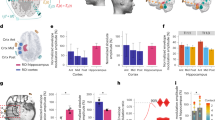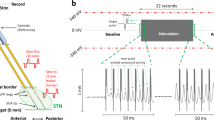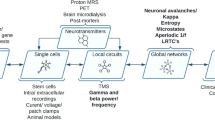Abstract
Approximately one quarter of individuals with an autism spectrum disorder (ASD) display self-injurious behavior (SIB) ranging from head banging to self-directed biting and punching. Sometimes, these behaviors are extreme and unresponsive to pharmacological and behavioral therapies. We have found electroconvulsive therapy (ECT) can produce life-changing results, with more than 90% suppression of SIB frequency. However, these patients typically require frequent maintenance ECT (mECT), as often as every 5 days, to sustain the improvement gained during the acute course. Long-term consequences of such frequent mECT started as early as childhood in some cases are unknown. Accordingly, there is a need for alternative forms of chronic stimulation for these patients. To explore the feasibility of deep brain stimulation (DBS) for intractable SIB seen in some patients with an ASD, we utilized two genetically distinct mouse models demonstrating excessive self-grooming, namely the Viaat-Mecp2−/y and Shank3B−/− lines, and administered high-frequency stimulation (HFS) via implanted electrodes at the subthalamic nucleus (STN-HFS). We found that STN-HFS significantly suppressed excessive self-grooming in both genetic lines. Suppression occurs both acutely when stimulation is switched on, and persists for several days after HFS is stopped. This effect was not explained by a change in locomotor activity, which was unaffected by STN-HFS. Likewise, social interaction deficits were not corrected by STN-HFS. Our data show STN-HFS suppresses excessive self-grooming in two autism-like mouse models, raising the possibility DBS might be used to treat intractable SIB associated with ASDs. Further studies are required to explore the circuitry engaged by STN-HFS, as well as other potential stimulation sites. Such studies might also yield clues about pathways, which could be modulated by non-invasive stimulatory techniques.
Similar content being viewed by others
Log in or create a free account to read this content
Gain free access to this article, as well as selected content from this journal and more on nature.com
or
References
Ahmari SE, Spellman T, Douglass NL, Kheirbek MA, Simpson HB, Deisseroth K et al (2013). Repeated cortico-striatal stimulation generates persistent OCD-like behavior. Science 340: 1234–1239.
American Psychiatric Association (2013) Diagnostic and Statistical Manual of Mental Disorders, 5th edn. American Psychiatric Press: Washington, DC, USA.
Baraban JM (2015). Viewing brain stimulation from a plasticity perspective. In: Reti IM (ed). Brain Stimulation: Methodologies and Interventions, 1st edn. Wiley Blackwell: NJ, USA, pp 45–56.
Bartak L, Rutter M (1976). Differences between mentally retarded and normally intelligent autistic children. J Autism Child Schizophr 6: 109–120.
Baumeister AA, Frye GD (1984). Self-injurious behavior in rats produced by intranigral microinjection of GABA agonists. Pharmacol Biochem Behav 21: 89–95.
Baup N, Grabli D, Karachi C, Mounayar S, Francois C, Yelnik J et al (2008). High-frequency stimulation of the anterior subthalamic nucleus reduces stereotyped behaviors in primates. J Neurosci 28: 8785–8788.
Berg AT, Plioplys S (2012). Epilepsy and autism: is there a special relationship? Epilepsy Behav 23: 193–198.
Bergman H, Katabi S, Slovik M, Deffains M, Arkadir D, Israel Z et al (2015). Motor pathways, basal ganglia physiology and pathophysiology. In: Reti IM (ed). Brain Stimulation: Methodologies and Interventions, 1st edn. Wiley Blackwell: NJ, USA, pp 29–44.
Billstedt E, Gillberg IC, Gillberg C (2005). Autism after adolescence: population-based 13- to 22-year follow-up study of 120 individuals with autism diagnosed in childhood. J Autism Dev Disord 35: 351–360.
Blumstein D, Evans C, Daniel J (2012). JWatcher. Available at: http://www.jwatcher.ucla.edu.
Cannon E, Silburn P, Coyne T, O'Maley K, Crawford JD, Sachdev PS (2012). Deep brain stimulation of anteromedial globus pallidus interna for severe Tourette's syndrome. Am J Psychiatry 169: 860–866.
Chao HT, Chen H, Samaco RC, Xue M, Chahrour M, Yoo J et al (2010). Dysfunction in GABA signalling mediates autism-like stereotypies and Rett syndrome phenotypes. Nature 468: 263–269.
Cheng JJ, Anderson WS, Lenz FA (2015). Neurological indications for deep brain stimulation. In: Reti IM (ed). Brain Stimulation: Methodologies and Interventions, 1st edn. Wiley Blackwell: NJ, USA, pp 271–288.
Chiken S, Nambu A (2014). Disrupting neuronal transmission: mechanism of DBS? Front Syst Neurosci 8: 33.
Cif L, Biolsi B, Gavarini S, Saux A, Robles SG, Tancu C et al (2007). Antero-ventral internal pallidum stimulation improves behavioral disorders in Lesch-Nyhan disease. Mov Disord 22: 2126–2129.
Consoli A, Cohen J, Bodeau N, Guinchat V, Wachtel L, Cohen D (2013). Electroconvulsive therapy in adolescents with intellectual disability and severe self-injurious behavior and aggression: a retrospective study. Eur Child Adolesc Psychiatry 22: 55–62.
Ducharme S, Flaherty AW, Seiner SJ, Dougherty DD, Morales OG (2011). Temporary interruption of deep brain stimulation for Parkinson's disease during outpatient electroconvulsive therapy for major depression: a novel treatment strategy. J Neuropsychiatry Clin Neurosci 23: 194–197.
Estes A, Shaw DW, Sparks BF, Friedman S, Giedd JN, Dawson G et al (2011). Basal ganglia morphometry and repetitive behavior in young children with autism spectrum disorder. Autism Res 4: 212–220.
Ferraro TN, Golden GT, Hare TA (1990). Repeated electroconvulsive shock selectively alters gamma-aminobutyric acid levels in the rat brain: effect of electrode placement. Convuls Ther 6: 199–208.
Fink M, Taylor MA (2006) Catatonia: A Clinician's Guide to Diagnosis and Treatment. Cambridge University Press: Cambridge, UK.
Franklin BJ, Paxinos GT (1996) The Mouse Brain in Stereotaxic Coordinates. Academic Press: NY, USA.
Ghaziuddin N, Dhossche D, Marcotte K (2012). Retrospective chart review of catatonia in child and adolescent psychiatric patients. Acta Psychiatr Scand 125: 33–38.
Groiss SJ, Wojtecki L, Sudmeyer M, Schnitzler A (2009). Deep brain stimulation in Parkinson's disease. Ther Adv Neurol Disord 2: 20–28.
Hagen E, Shprung D, Minakova E, Washington J, Kumar U, Shin D et al (2015). Autism-like behavior in BTBR mice is improved by electroconvulsive therapy. Neurotherapeutics 12: 657–666.
Haq AU, Ghaziuddin N (2014). Maintenance electroconvulsive therapy for aggression and self-injurious behavior in two adolescents with autism and catatonia. J Neuropsychiatry Clin Neurosci 26: 64–72.
Heida T, Marani E, Usunoff KG (2008). The subthalamic nucleus part II: modelling and simulation of activity. Adv Anat Embryol Cell Biol 199: 1–85, vii.
Kronenbuerger M, Fromm C, Block F, Coenen VA, Rohde I, Rohde V et al (2006). On-demand deep brain stimulation for essential tremor: a report on four cases. Mov Disord 21: 401–405.
Lewis M, Kim SJ (2009). The pathophysiology of restricted repetitive behavior. J Neurodev Disord 1: 114–132.
Little S, Pogosyan A, Neal S, Zavala B, Zrinzo L, Hariz M et al (2013). Adaptive deep brain stimulation in advanced Parkinson disease. Ann Neurol 74: 449–457.
Luigjes J, de Kwaasteniet BP, de Koning PP, Oudijn MS, van den Munckhof P, Schuurman PR et al (2013). Surgery for psychiatric disorders. World Neurosurg 80: S31.e17–e28.
Lunde ME, Lee EK, Rasmussen KG (2006). Electroconvulsive therapy in patients with epilepsy. Epilepsy Behav 9: 355–359.
Minshawi NF, Hurwitz S, Fodstad JC, Biebl S, Morriss DH, McDougle CJ (2014). The association between self-injurious behaviors and autism spectrum disorders. Psychol Res Behav Manag 7: 125–136.
Montgomery EB (2010) Deep Brain Stimulation Programming: Principles and Practice. Oxford University Press: Oxford, UK.
Morishita T, Foote KD, Burdick AP, Katayama Y, Yamamoto T, Frucht SJ et al (2010). Identification and management of deep brain stimulation intra- and postoperative urgencies and emergencies. Parkinsonism Relat Disord 16: 153–162.
Muehlmann AM, Lewis MH (2012). Abnormal repetitive behaviours: shared phenomenology and pathophysiology. J Intellect Disabil Res 56: 427–440.
Nair G, Evans A, Bear RE, Velakoulis D, Bittar RG (2014). The anteromedial GPi as a new target for deep brain stimulation in obsessive compulsive disorder. J Clin Neurosci 21: 815–821.
O'Donovan S, Kennedy M, Guinan B, O'Mara S, McLoughlin DM (2012). A comparison of brief pulse and ultrabrief pulse electroconvulsive stimulation on rodent brain and behaviour. Prog Neuropsychopharmacol Biol Psychiatry 37: 147–152.
Peca J, Feliciano C, Ting JT, Wang W, Wells MF, Venkatraman TN et al (2011). Shank3 mutant mice display autistic-like behaviours and striatal dysfunction. Nature 472: 437–442.
Peterchev AV, Rosa MA, Deng ZD, Prudic J, Lisanby SH (2010). Electroconvulsive therapy stimulus parameters: rethinking dosage. J ECT 26: 159–174.
Prosée R, Denys D (2015). Psychiatric indications for deep brain stimulation. In: Reti IM (ed). Brain Stimulation: Methodologies and Interventions, 1st edn. Wiley Blackwell: NJ, USA, pp 289–304.
Reti IM (2015). How does electroconvulsive therapy work? In: Reti IM (ed). Brain Stimulation: Methodologies and Interventions, 1st edn. Wiley Blackwell: NJ, USA, pp 107–122.
Reti IM, Baraban JM (2000). Sustained increase in Narp protein expression following repeated electroconvulsive seizure. Neuropsychopharmacology 23: 439–443.
Reti IM, Chang AD (2015). Introduction to brain stimulation. In: Reti IM (ed). Brain Stimulation: Methodologies and Interventions, 1st edn. Wiley Blackwell: NJ, USA, pp 1–12.
Richards C, Oliver C, Nelson L, Moss J (2012). Self-injurious behaviour in individuals with autism spectrum disorder and intellectual disability. J Intellect Disabil Res 56: 476–489.
Sackeim HA, Prudic J, Nobler MS, Fitzsimons L, Lisanby SH, Payne N et al (2008). Effects of pulse width and electrode placement on the efficacy and cognitive effects of electroconvulsive therapy. Brain Stimul 1: 71–83.
Sanacora G, Mason GF, Rothman DL, Hyder F, Ciarcia JJ, Ostroff RB et al (2003). Increased cortical GABA concentrations in depressed patients receiving ECT. Am J Psychiatry 160: 577–579.
Scheel-Kruger J, Magelund G, Olianas M (1981). The role of GABA in the basal ganglia and limbic system for behaviour. Adv Biochem Psychopharmacol 29: 23–36.
Shattuck PT, Seltzer MM, Greenberg JS, Orsmond GI, Bolt D, Kring S et al (2007). Change in autism symptoms and maladaptive behaviors in adolescents and adults with an autism spectrum disorder. J Autism Dev Disord 37: 1735–1747.
Silverman JL, Yang M, Lord C, Crawley JN (2010). Behavioural phenotyping assays for mouse models of autism. Nat Rev Neurosci 11: 490–502.
Sokhadze EM, El-Baz AS, Sears LL, Opris I, Casanova MF (2014). rTMS neuromodulation improves electrocortical functional measures of information processing and behavioral responses in autism. Front Syst Neurosci 8: 134.
Stocco A, Baizabal-Carvallo JF (2014). Deep brain stimulation for severe secondary stereotypies. Parkinsonism Relat Disord 20: 1035–1036.
Sturm V, Fricke O, Buhrle CP, Lenartz D, Maarouf M, Treuer H et al (2013). DBS in the basolateral amygdala improves symptoms of autism and related self-injurious behavior: a case report and hypothesis on the pathogenesis of the disorder. Front Hum Neurosci 6: 341.
Taira T, Kobayashi T, Hori T (2003). Disappearance of self-mutilating behavior in a patient with lesch-nyhan syndrome after bilateral chronic stimulation of the globus pallidus internus. Case report. J Neurosurg 98: 414–416.
Tehovnik EJ (1996). Electrical stimulation of neural tissue to evoke behavioral responses. J Neurosci Methods 65: 1–17.
Vila-Rodriguez F, McGirr A, Tham J, Hadjipavlou G, Honey CR (2014). Electroconvulsive therapy in patients with deep brain stimulators. J ECT 30: e16–e18.
Wachtel L, Commins E, Park M, Rolider N, Stephens R, Reti I (2015). Neuroleptic malignant syndrome and delirious mania as malignant catatonia in autism: prompt relief with electroconvulsive therapy. Acta Psychiatr Scand 132: 319–320.
Wachtel LE, Contrucci-Kuhn SA, Griffin M, Thompson A, Dhossche DM, Reti IM (2009). ECT for self-injury in an autistic boy. Eur Child Adolesc Psychiatry 18: 458–463.
Wachtel LE, Dhossche D (2013). ECT for self-injurious behavior. In: Ghaziuddin N, Walter G (eds). Electroconvulsive Therapy for Children and Adolescents. Oxford University Press: Oxford, UK, pp 247–280.
Wachtel LE, Dhossche DM, Reti IM, Hughes-Wheatland R (2012). Stability of intellectual functioning during maintenance electroconvulsive therapy. Pediatr Neurol 47: 219–221.
Wachtel LE, Griffin M, Reti IM (2010). Electroconvulsive therapy in a man with autism experiencing severe depression, catatonia, and self-injury. J ECT 26: 70–73.
Wachtel LE, Kahng S, Dhossche DM, Cascella N, Reti IM (2008). ECT for catatonia in an autistic girl. Am J Psychiatry 165: 329–333.
Wachtel LE, Reti IM, Dhossche DM, Slomine BS, Sanz J (2011). Stability of neuropsychological testing during two years of maintenance electroconvulsive therapy in an autistic man. Prog Neuropsychopharmacol Biol Psychiatry 35: 301–302.
Wachtel LE, Reti IM, Ying H (2014). Stability of intraocular pressure after retinal reattachment surgery during electroconvulsive therapy for intractable self-injury in a 12-year-old autistic boy. J ECT 30: 73–76.
Wing L, Shah A (2000). Catatonia in autistic spectrum disorders. Br J Psychiatry 176: 357–362.
Acknowledgements
We thank Dr Wayne Frankel at Jackson Laboratory for providing Viaat-cre mice, and Dr Hsiao-Tuan Chao for advice on genotyping and maintaining the Viaat-mecp2−/y colony.
Author information
Authors and Affiliations
Corresponding author
Additional information
Supplementary Information accompanies the paper on the Neuropsychopharmacology website
Supplementary information
Rights and permissions
About this article
Cite this article
Chang, A., Berges, V., Chung, S. et al. High-Frequency Stimulation at the Subthalamic Nucleus Suppresses Excessive Self-Grooming in Autism-Like Mouse Models. Neuropsychopharmacol 41, 1813–1821 (2016). https://doi.org/10.1038/npp.2015.350
Received:
Revised:
Accepted:
Published:
Issue date:
DOI: https://doi.org/10.1038/npp.2015.350
This article is cited by
-
A subthalamo-parabrachial glutamatergic pathway is involved in stress-induced self-grooming in mice
Acta Pharmacologica Sinica (2023)
-
Continuous high-frequency deep brain stimulation of the anterior insula modulates autism-like behavior in a valproic acid-induced rat model
Journal of Translational Medicine (2022)
-
Deep phenotyping reveals movement phenotypes in mouse neurodevelopmental models
Molecular Autism (2022)
-
iPSC toolbox for understanding and repairing disrupted brain circuits in autism
Molecular Psychiatry (2022)
-
Functional analysis of distinct populations of subthalamic nucleus neurons on Parkinson’s disease and OCD-like behaviors in mice
Molecular Psychiatry (2021)



